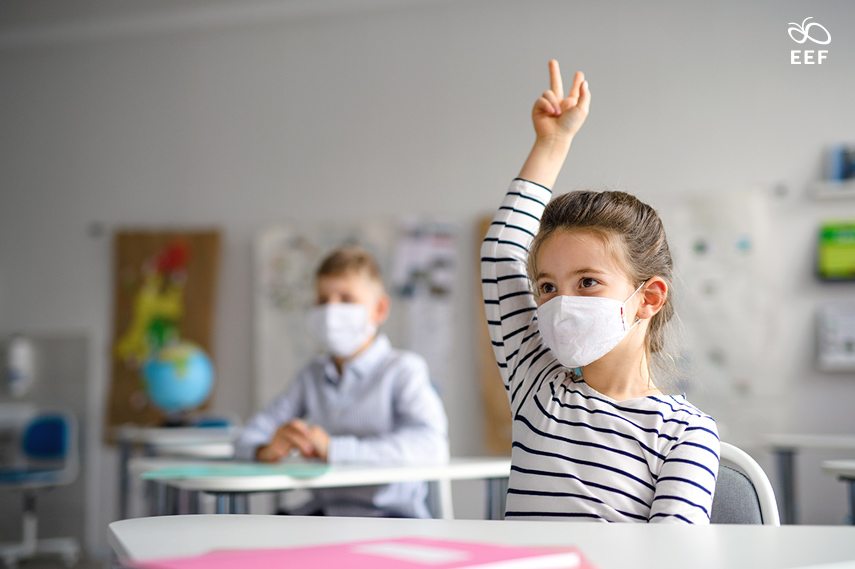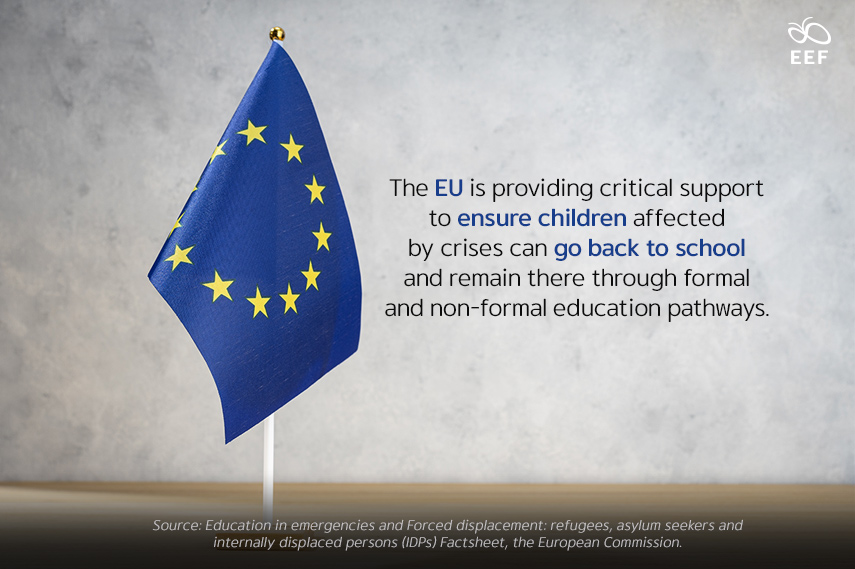
Every child has a fundamental right to education, but for those caught up amid humanitarian crises, this right becomes a distant dream. Displacement, violence, and poverty are only a few of the unimaginable obstacles standing in the way of quality education. Wars and conflicts leave children with no sense of normalcy, forcing them to endure the loss of homes and loved ones and rendering them vulnerable and susceptible to exploitation and abuse. Unfortunately, without education, their chances of escaping poverty and building a better future for themselves and their communities are severely limited.
Education is one of the most powerful tools for investing in peace, stability, and economic growth. It is crucial to give them a better future, develop their full potential, and equip them with the skills and protection needed to restore their sense of normality and safety. However, despite the sustainable development goal of ensuring quality education for every child, education is one of the most underfunded areas of humanitarian aid, with only around 3% of global humanitarian funding allocated to it. This lack of funding has left 260 million children without access to primary or secondary school. Furthermore, refugee children are especially affected, with only 77% enrolled in primary school and a meager 31% in secondary school.
Moreover, the education of children is often targeted during armed conflict or insecurity. Over the past five years, there have been over 11,000 attacks on education, resulting in more than 22,000 students, teachers, and academics being injured, killed, or harmed. This violence perpetuates a cycle of poverty, instability, and inequality, preventing children from accessing the education they need to build better futures for themselves and their communities. Furthermore, the COVID-19 pandemic has also exacerbated the negative trends and provoked a worldwide education crisis, with over 463 million children globally unable to access remote learning during school closures. This has put 222 million crisis-affected children and youth in urgent need of educational support. Urgent action is needed to ensure that every child, regardless of their circumstances, has access to quality education.
In light of these challenges, it is critical to prioritize education in humanitarian responses and ensure that children have access to safe and quality education. By investing in education, we can provide children caught in humanitarian crises with the tools they need to thrive, build peaceful and stable societies, and realize their full potential.

The impact of wars and conflicts is felt most acutely by children, who are often left with no access to education. For these children, the opportunity to learn and receive an education is not only a means of personal growth and empowerment but also a crucial step toward breaking the cycle of violence and poverty that plagues their lives. The path to education, however, is still filled with obstacles, such as limited resources and qualified personnel, coupled with the constant risk of violence and exploitation. Nevertheless, despite the daunting challenges, numerous dedicated organizations and individuals are working tirelessly to provide access to education to children in conflict zones and refugee camps, of particular note is the European Union (EU).
Recognizing the crucial role education plays in restoring normalcy and security to children’s lives, the EU has made education a top priority in its humanitarian and development funding instruments. It has been taking a proactive stance on this issue, implementing a series of policies on education in emergencies and protracted crises to provide critical support to teachers and create safe learning spaces, thereby minimizing the impact of such situations on children’s learning.

The EU is providing critical support to ensure children affected by crises can go back to school and remain there through formal and non-formal education pathways. This includes training and coaching for teachers, as well as protection actions to safeguard the learning environment. As part of this effort, it is increasingly focusing on protecting education from attack, rolling out the Safe Schools Declaration, and integrating protection elements into over 65% of EU-funded actions on education in emergencies. By doing so, the EU is helping to create safe and secure learning spaces that link children to specialized child protection services when needed.
The EU has set clear priorities for supporting education in emergencies, which include partnerships for a rapid, efficient, effective, and innovative education response, promoting access, inclusion, and equity, championing education for peace and protection, and supporting quality education for better learning outcomes. These priorities are outlined in the European Commission’s Communication on Education in Emergencies in Protracted Crises, which was endorsed by EU countries.
The EU has invested over €970 million in education in emergencies between 2015 and 2022, making it one of the top donors and policy shapers in the field. The EU-funded educational projects have benefited over 20 million girls and boys who have been affected by crises in 63 different countries, whose humanitarian funding is delivered through its partners, such as NGOs, United Nations agencies, and international organizations. For 2023, the EU has set a funding target of €158 million.
The EU supports a wide range of actions, including, in addition to formal and non-formal learning activities, providing teaching and learning materials, training and mentoring teachers and other education workers, providing psychosocial support, and life skills training. The EU’s projects also focus on rehabilitating and improving school infrastructure, promoting the protection of schools, and community sensitization and awareness-raising. The EU-funded actions support children and teachers in both formal and non-formal education, including accelerated education programs that help children reach the grade corresponding to their age. The EU’s projects focus on children living in host communities, internally displaced children, and refugee children. Innovative solutions for students and teachers are also included in approximately 1/5 of all actions.
Through its efforts, the EU has significantly improved the lives of many children, even in crisis-affected areas, by providing them with access to education. The EU’s commitment to providing education to children in emergencies has enabled them to acquire essential skills and knowledge to build a better future. The EU’s comprehensive approach to education in emergencies has also helped to reduce the impact of crises on children’s education, ensuring that they can continue to learn and grow despite the difficult circumstances they face.

As we navigate the post-COVID-19 world, ensuring access to quality education for all children remains more critical than ever, and the EU’s commitment to this cause is a shining example of how global partnerships can make a real difference in the lives of children and families affected by crises. This is in line with the mission of the Equitable Education Fund (EEF) Thailand, which is to reduce education and employment inequality through research, collaboration, and support for children, youth, and adults in need.
Source:

